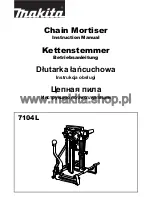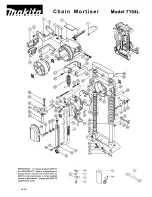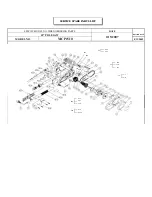
16
English
For the most efficient cutting action, set the depth adjustment so that
1/2 tooth of the blade will project below the material to be cut. This
distance is from the tip of the tooth to the bottom of the gullet in front
of it. This keeps blade friction at a minimum, removes sawdust from
the cut, results in cooler, faster sawing and reduces the chance of
kickback. A method for checking for correct cutting depth is shown in
Figure 7. Lay a piece of the material you plan to cut along the side of
the blade, as shown, and observe how much tooth projects beyond
the material.
NOTE:
When using carbide-tipped blades, make an exception to
the above rule and allow only one-half of a tooth to project below the
material to be cut.
Bevel Angle Adjustment (Fig. 7)
The full range of the bevel adjustment is from 0˚ to 50˚. The quadrant is
graduated in increments of 1˚. On the front of the saw is a bevel angle
adjustment mechanism (Fig. 7) consisting of a calibrated quadrant and
a knob (J).
TO SET THE SAW FOR A BEVEL CUT
1. Loosen (counterclockwise) the bevel adjustment knob (J) and tilt
shoe to the desired angle by aligning the pointer with the desired
angle mark.
2. Retighten knob firmly (clockwise).
Shoe Adjustment for 90˚ Cuts
IF ADDITIONAL ADJUSTMENT IS NEEDED:
1. Adjust the saw to 0˚ bevel.
2. Retract blade guard. Place the saw on blade side.
3. Loosen bevel adjustment knob. Place a square against the blade
and shoe to adjust the 90˚ setting.
4. Move the adjustment screw so that the shoe will stop at the proper
angle.
5. Confirm the accuracy of the setting by checking the squareness of
an actual cut on a scrap piece of material.
Kerf Indicator
The front of the saw shoe has a kerf indicator for vertical and bevel
cutting. This indicator enables you to guide the saw along cutting lines
penciled on the material being cut. The indicator lines up with the left
(outer) side of the saw blade, which makes the slot or “kerf” cut by the
moving blade fall to the right of the indicator. Guide along the penciled
cutting line so that the kerf falls into the waste or surplus material.
Work Piece Support (Fig. 8–10)
WARNING:
It is important to support the work properly and to hold
the saw firmly to prevent loss of control which could cause personal
injury. Figure 8 illustrates proper hand support of the saw. Maintain a
firm grip with both hands on the saw and position your body and arm
to allow you to resist kickback if it occurs. ALWAYS TURN OFF TOOL
AND REMOVE BATTERY BEFORE MAKING ANY ADJUSTMENTS!
Figure 8 shows proper sawing position. Note that hands are kept
away from cutting area. To avoid kickback, DO support board or panel
NEAR the cut (Fig. 9). DON’T support board or panel away from the
cut (Fig. 10).
FIG. 8





































